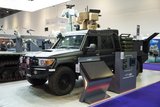Lockheed Martin supports real-time ISR for Red Flag
The Distributed Common Ground Station Imagery (DCGS-I) mobile test bed modernised by Lockheed Martin in 2012 has been used to provide advanced exploitation of intelligence, surveillance and reconnaissance (ISR) capabilities during the US Air Force aerial warfare Red Flag exercise.
The DCGS-I is used by the US Department of Defence to test ISR capabilities prior to their introduction into an operational environment. During Red Flag, live imagery from manned and unmanned aircraft was disseminated in near real-time to the DCGS-I at a ‘level never before achieved’, the company said.
Lt. Col. Christopher Reiz, the 526th Intelligence Squadron commander, said: ‘Red Flag was a huge success, and a large chunk was due to the DCGS-I capabilities. DCGS-I was a critical part of our High Altitude mission and pivotal to the successful execution of reconnaissance missions and in providing realistic combat training.’
Red Flag exercises are realistic aerial war games intended to prepare pilots from the US, NATO and other allied countries for combat situations. According to Lockheed Martin, this is the first time that the US Air Force brought together not just the platform and supporting sensors, but also the analysis of the collected intelligence data, as well as the communications paths upon which the data travels.
Jim Quinn, vice president of C4ISR systems for Lockheed Martin Information Systems & Global Solutions, said: ‘This is a major step forward in exploring the true potential of real-time intelligence. The value that analysing and sharing ISR data offers for success in future conflicts is clear: a holistic understanding of a complex battlespace.’
During Red Flag, raw intelligence from manned and unmanned ISR assets was sent to DCGS-I, which served as the primary data link, processor, and delivery mechanism for the Synthetic Aperture Radar (SAR) imagery taken from the U-2, as well as the backup data link for the SAR and infrared imagery taken by the Global Hawk. Analysts reviewed the data, and in collaboration with the Air Operations Center, sent the intelligence products to users, allowing for a more effective prioritisation of combat assets.
Users from dissimilar classification environments were able to review imagery gleaned from the airborne platforms through the use of Lockheed Martin's cross domain solution Trusted Manager (TMAN). TMAN automatically disseminated imagery from the secret DCGS-I environment to the top secret Air Force common workstations, allowing airmen to work seamlessly at both the secret and top secret security levels.
More from Digital Battlespace
-
![Babcock nears first customer for Nomad AI translation tool]()
Babcock nears first customer for Nomad AI translation tool
Nomad can provide militaries with real-time intelligence, saving critical time on the battlefield.
-
![AUSA 2025: Israel’s Asio Technologies to supply hundreds of improved Taurus tactical systems]()
AUSA 2025: Israel’s Asio Technologies to supply hundreds of improved Taurus tactical systems
Taurus operates alongside the Israel Defense Forces’ Orion system which supports mission management across tens of thousands of manoeuvring forces, from squad leaders to battalion commanders.
-
![AUSA 2025: Kopin pushes micro-LED plans as China moves faster]()
AUSA 2025: Kopin pushes micro-LED plans as China moves faster
The plan for the new displays follows fresh investment in Kopin’s European facilities by Theon and an order for head-up displays in fielded aircraft, with funding from the US Department of Defense.
-
![AUSA 2025: Persistent Systems to complete its largest order by year’s end]()
AUSA 2025: Persistent Systems to complete its largest order by year’s end
Persistent Systems received its largest ever single order for its MPU5 devices and other systems earlier this month and has already delivered the 50 units to the US Army’s 4th Infantry Division.
-
![Aselsan brings in dozens of companies and systems under the Steel Dome umbrella]()
Aselsan brings in dozens of companies and systems under the Steel Dome umbrella
Turkey has joined the family of countries attempting to establish a multilayered air defence system with government approval in August 2024 for the effort landed by Aselsan. Dubbed Steel Dome, the programme joins Israel’s Iron Dome, the US Golden Dome, India’s Mission Sudarshan Chakra and South Korea’s low-altitude missile defence system.
-
![DSEI 2025: MARSS unveils new agnostic multidomain C4 system]()
DSEI 2025: MARSS unveils new agnostic multidomain C4 system
MARSS’ NiDAR system has been deployed using sensors from static platforms to provide detection and protection for static sights, such as critical infrastructure, ports and military bases.



























